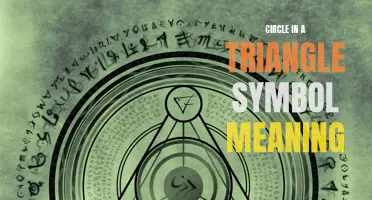
Have you ever wondered what those mysterious symbols on your clothing tags mean? They may look like hieroglyphics, but they actually hold important information about how to properly care for your clothes. These fabric care symbols can save you from accidentally shrinking your favorite sweater or ruining your new pair of jeans. In this article, we will decode the hidden meanings behind these symbols, so you can keep your clothes looking their best for longer.
What You'll Learn
- What are the different fabric care symbols and what do they mean?
- How can understanding fabric care symbols help in properly caring for clothing?
- Are fabric care symbols universal or do they vary by country or region?
- Is it possible to damage clothing if the fabric care symbols are not followed?
- Where can one find a comprehensive guide to fabric care symbols and their meanings?

What are the different fabric care symbols and what do they mean?
When it comes to caring for clothes, it’s important to pay attention to the laundry symbols on the care labels. These symbols provide important information about how to properly care for and clean different types of fabric. By understanding these symbols, you can ensure that your clothes are properly cleaned and maintained, extending their lifespan and keeping them looking their best. Here are some of the most common fabric care symbols and what they mean:
Washing Symbols:
- Machine Wash: This symbol indicates that the item can be safely washed in a washing machine.
- Hand Wash: This symbol indicates that the item should be washed by hand and not in a washing machine.
- Do Not Wash: This symbol indicates that the item should not be washed. It may require dry cleaning or spot cleaning instead.
Bleaching Symbols:
- Bleach When Needed: This symbol indicates that the item can be safely bleached when necessary.
- Do Not Bleach: This symbol indicates that the item should not be bleached.
Drying Symbols:
- Tumble Dry: This symbol indicates that the item can be safely dried in a tumble dryer.
- Line Dry: This symbol indicates that the item should be dried by hanging it on a clothesline or drying rack.
- Do Not Tumble Dry: This symbol indicates that the item should not be dried in a tumble dryer.
Ironing Symbols:
- Iron: This symbol indicates that the item can be safely ironed.
- Do Not Iron: This symbol indicates that the item should not be ironed.
Dry Cleaning Symbols:
- Dry Clean: This symbol indicates that the item should be taken to a professional dry cleaner for cleaning.
- Do Not Dry Clean: This symbol indicates that the item should not be dry cleaned.
Additional Symbols:
- Temperature: This symbol indicates the maximum temperature at which the item can be safely washed or ironed.
- Delicate Cycle: This symbol indicates that the item should be washed on a delicate or gentle cycle.
- Do Not Wring: This symbol indicates that the item should not be twisted or wrung out to remove excess water.
It’s important to always follow the care instructions provided by the manufacturer and to pay attention to any additional instructions or warnings on the care label. Properly caring for your clothes according to the fabric care symbols can help prevent damage, shrinkage, color fading, and other issues that can occur during the cleaning process. By taking the time to understand and follow these symbols, you can keep your clothes in great condition for longer.
Understanding the Toyota Avalon Dashboard Symbols and Meanings
You may want to see also

How can understanding fabric care symbols help in properly caring for clothing?
Understanding fabric care symbols can greatly assist in properly caring for clothing. These symbols provide essential information about how to wash, dry, and iron different types of fabrics, ensuring that they remain in excellent condition for as long as possible. By following these symbols, individuals can avoid damaging their clothes and help them last longer.
One of the most common fabric care symbols is the washing symbol, which indicates the appropriate water temperature and cycle for washing the garment. The symbols range from a basic tub indicating normal washing to symbols depicting cold water, warm water, and hot water. Following these symbols ensures that the garment is washed at the correct temperature, preventing color fading and shrinkage.
Fabric care symbols also provide information about the proper drying methods for different fabrics. Some garments should not be tumble dried and require air drying instead. The symbol for air drying is a square with a circle inside, while the symbol for tumble drying is a square with a circle and a curved line inside. By following these symbols, individuals can prevent their clothing from shrinking or becoming damaged due to excessive heat.
Ironing symbols are another key component of fabric care symbols. They provide information about the appropriate temperature settings for ironing different fabrics. The symbols range from a basic iron indicating a high temperature to symbols depicting one or two dots, indicating a low or medium temperature setting respectively. Ironing clothes at the correct temperature helps prevent scorching and melting of fabrics, keeping them looking crisp and presentable.
Understanding fabric care symbols can also help individuals determine whether a garment can be bleached or not. The bleach symbol is typically a triangle, with a single line inside indicating non-chlorine bleach and two lines indicating chlorine bleach. By following these symbols, individuals can avoid accidentally damaging their garments or causing discoloration.
In addition to these basic fabric care symbols, manufacturers may also include additional symbols that provide specific instructions for care. These may include symbols for hand washing, dry cleaning, or special care instructions. By paying attention to these symbols, individuals can ensure that their clothing is cared for properly, extending their lifespan and maintaining their appearance.
In conclusion, understanding fabric care symbols can be extremely beneficial in properly caring for clothing. By following these symbols' instructions for washing, drying, ironing, and bleaching, individuals can prevent damage to their garments and help them last longer. By taking the time to familiarize themselves with these symbols, individuals can maintain their clothing's appearance and quality for as long as possible.
Decoding the Symbols: What Do the Symbols Mean on Onlyfans?
You may want to see also

Are fabric care symbols universal or do they vary by country or region?
Fabric care symbols are universal symbols used on clothing labels to provide instructions on how to properly care for garments. These symbols are designed to be easily recognizable and understandable regardless of language or region. However, there may be slight variations in the specific symbols used in different countries or regions.
The International Organization for Standardization (ISO) has developed a standardized system of fabric care symbols that is widely used around the world. This system consists of a set of pictograms that represent different care instructions such as washing, drying, ironing, bleaching, and dry cleaning. These symbols are often accompanied by additional text or specific instructions in the language of the country where the garment is sold.
While the basic meanings of fabric care symbols remain the same across different countries and regions, there may be slight variations in the specific symbols used. For example, a washing symbol may be represented by a bucket of water in one country, while it may be represented by a washing machine in another. Similarly, a drying symbol may be represented by a square with a circle inside in one country, while it may be represented by a dot inside a square in another.
To address these variations and ensure consistent understanding, the ISO has developed guidelines for the design and interpretation of fabric care symbols. These guidelines aim to establish a common understanding of the symbols and minimize confusion. Manufacturers and retailers are encouraged to use these standardized symbols to provide consumers with clear and consistent instructions on how to care for their garments.
In addition to the standardized symbols, some countries or regions may also have their own additional fabric care symbols. For example, in Japan, there is a symbol for "do not wring," which is not included in the ISO system. These additional symbols are specific to certain regions and may not be widely recognized or understood outside of those areas.
Overall, fabric care symbols are meant to provide universal instructions for garment care. While there may be slight variations in the specific symbols used in different countries or regions, the basic meanings of the symbols remain the same. It is important for consumers to familiarize themselves with the fabric care symbols used in their country or region to ensure proper care of their garments. Manufacturers and retailers have a responsibility to use standardized symbols and provide clear instructions to consumers to avoid any confusion.
Decoding the Mystery: Demystifying Range Rover Dashboard Symbols
You may want to see also

Is it possible to damage clothing if the fabric care symbols are not followed?
Taking care of our clothing is essential to ensure that they stay in good condition and last longer. One of the ways to properly care for our garments is by following the fabric care symbols on the label. These symbols provide instructions on how to clean and handle the clothing, and disregarding them can certainly lead to damage.
The fabric care symbols are internationally recognized and each symbol represents a specific instruction for the care of the garment. They cover various aspects like washing, drying, ironing, bleaching, and dry cleaning. Ignoring these symbols, especially when it comes to washing and drying methods, can have negative consequences.
The most immediate risk of not following the fabric care symbols is shrinkage. Certain fabrics are more prone to shrinkage when exposed to high heat or vigorous washing methods. For example, washing a garment that should be dry cleaned or using high heat while drying it can cause it to shrink significantly. This can lead to the garment becoming too small or tight to wear, rendering it useless.
Another potential risk is color bleeding or fading. Some fabrics are more susceptible to color transfer or fading when exposed to certain conditions or cleaning agents. If a garment is labeled as "hand wash only" and it is instead thrown into the washing machine, there is a higher chance of the colors bleeding or fading. This can result in the garment looking dull, discolored, or uneven after washing.
Certain garments also require specific temperature settings while ironing. Ironing at a higher temperature than recommended can scorch and permanently damage the fabric. This can leave unsightly burn marks or shine on the garment that cannot be reversed. Additionally, fabrics like silk or delicate lace may require special care and ironing them at high temperatures can cause them to lose their shape or integrity.
Lastly, some garments are labeled as "dry clean only" for a reason. Dry cleaning involves professional cleaning with specialized chemicals that are gentle on the fabric. Attempting to wash these garments at home can result in damage, as the cleaning agents used for regular laundry may be too harsh. The fabric can lose its texture, shrink, lose color, or even fall apart.
In conclusion, not following the fabric care symbols on clothing labels can definitely lead to damage. Shrinkage, color bleeding or fading, scorching, and loss of texture are all potential risks of disregarding these symbols. To ensure that our clothing remains in good condition, lasts longer, and retains its original appearance, it is crucial to follow the fabric care instructions provided. By doing so, we can prevent unnecessary damage and prolong the lifespan of our garments.
Uncovering the Hidden Secrets: Exploring the Symbolic Meaning of Herbs
You may want to see also

Where can one find a comprehensive guide to fabric care symbols and their meanings?
When it comes to caring for our clothes and other fabrics, understanding the fabric care symbols is crucial. These symbols are usually found on clothing tags or labels, and they provide important information about how to properly clean and maintain the fabric.
If you're not familiar with these symbols or their meanings, don't worry! There are many resources available to help you decipher them and ensure that you're taking the best possible care of your garments.
One excellent resource for finding a comprehensive guide to fabric care symbols and their meanings is the website of the International Organization for Standardization (ISO). ISO is an independent, non-governmental international organization that develops and publishes standards. They have a dedicated section on their website that provides information on fabric care symbols and their meanings.
On the ISO website, you can find a detailed guide that explains each symbol and what it represents. The guide covers symbols for washing, bleaching, drying, ironing, and professional textile care. It also includes explanations of various additional symbols that may be present, such as those indicating the use of specific solvents or cleaning methods.
Another useful resource for understanding fabric care symbols is the website of the American Cleaning Institute (ACI). The ACI provides a comprehensive guide to fabric care symbols that is easy to understand and navigate. Their website also offers additional information on fabric care and stain removal, making it a valuable resource for anyone looking to take better care of their clothes.
Additionally, many detergent manufacturers and clothing care brands provide guides or charts explaining fabric care symbols on their websites. These guides often contain helpful information about specific fabric types and how to care for them. For example, if you're unsure about the care symbol for silk, you can search for a guide specifically tailored to caring for silk garments.
If you prefer a physical reference guide, you can also find books and laminated cards that provide a comprehensive overview of fabric care symbols. These resources can be particularly handy if you often find yourself needing to interpret fabric care symbols on the go.
In conclusion, understanding fabric care symbols is essential for maintaining the longevity and quality of your clothes and other fabrics. Thankfully, there are many resources available to help you decode these symbols and ensure that you care for your garments properly. Websites such as the ISO and ACI provide comprehensive guides to fabric care symbols, while detergent manufacturers and clothing care brands often offer their own resources as well. Whether you prefer online guides or physical reference materials, you'll be able to find a resource that suits your needs and helps you care for your fabrics effectively.
Exploring the Historical Significance and Meaning of the Snake on the Medical Symbol
You may want to see also
Frequently asked questions
Fabric care symbols are pictograms that provide information about how to properly care for a particular garment. They indicate whether the item can be machine washed or must be hand washed, if it can be ironed and at what temperature, and if it can be dry cleaned or tumble dried. These symbols are standardized and universally recognized, making it easier for consumers to understand how to best care for their clothing.
The symbol of a tub filled with water indicates that the item can be machine washed. The number inside the tub represents the maximum temperature at which the garment can be washed. For example, a tub with one line underneath it means the item can be washed at a maximum temperature of 30 degrees Celsius, while a tub with two lines means the maximum temperature is 40 degrees Celsius.
The symbol of a hand represents that the item should be hand washed. This means that the garment is too delicate or prone to damage in a washing machine and should be washed by hand using a gentle detergent and lukewarm water. It is important to thoroughly rinse the garment and avoid wringing it out, as this can cause stretching or distortion.
The symbol of an iron indicates whether the garment can be ironed and at what temperature. The number inside the iron symbol represents the maximum temperature setting that can be used. For example, an iron with one dot means the garment can be ironed at a low temperature, while an iron with three dots means a high temperature can be used. It is important to use the appropriate ironing temperature for the fabric to avoid scorching or burning.
The symbol of a circle represents that the garment can be dry cleaned. The letters inside the circle indicate which chemicals can be used in the dry cleaning process. For example, the letters P and F indicate that any solvent can be used, while the letter F alone indicates that only petroleum solvent should be used. It is important to follow these symbols to ensure the garment is cleaned properly without causing damage.







